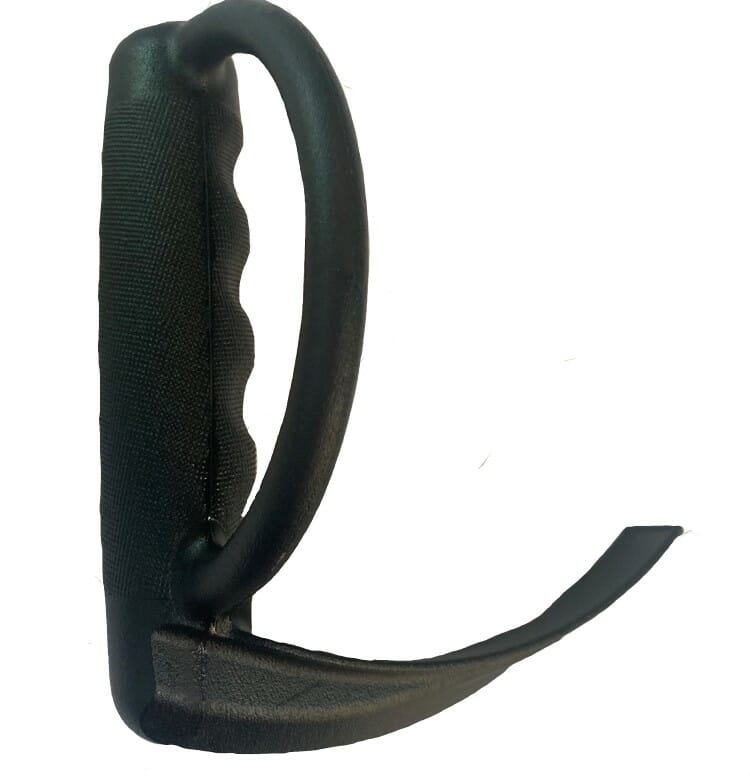B-Vector Laryngoscope*
Vargo Anesthesia Innovations, LLC is currently looking for a development partner, medical device entrepreneurs and other professionals who share this vision. *Patent pending

Batteries (and engineering around them) have hindered the sterilization of direct laryngoscopes for decades. According to the American Society of Anesthesiologists (ASA), laryngoscopes are semi-critical devices requiring high-level disinfection or sterilization between uses. Likewise, the Center for Disease Control (CDC) effectively classifies the laryngoscope as such by deference to manufacturers Instructions for Use (IFU) (7,8). Batteries and complexity, however, make efficient sterilization impossible due to costly labor, reduced lifespan, and a rapid decline in reliability that places patients at risk of injury and death. Simply utilizing antimicrobial wipes has been ineffective and contaminated laryngoscopes have been documented to be the cause of Hospital Acquired Infection (HAI) and death since the 1970s (6).
Despite these facts, there remains great difficulty and uncertainty in standardization of laryngoscope reprocessing even today (6). As a result, Single Use Disposable (SUD) laryngoscopes have gained favor and account for 50% of intubations and 3.5 M pounds of infectious waste into the US environment every year. When considering the ever-present threats of supply chain disruption (i.e. COVID), you now have a recipe for continued HAI’s, soaring costs and non-sustainability. This can all change with the B-Vector laryngoscope.
The B-Vector is a direct laryngoscope prototype that contains no batteries, nor does it require an attached power cord. As a result, it is an integral hand-held instrument that needs no disassembly/reassembly. It can be sterilized in minutes – as easily as surgical instruments sent through central processing in hundreds of facilities every day; anywhere there is a steam autoclave. When returned to the operating room, it can be stored as 100% sterile until point of use, and can even have its bright LED tested without removing it from its sterile package. No current reusable laryngoscope can compare. Additionally, the B-Vector can be a platform for a reusable, easily sterilized direct laryngoscope handle with an ISO 7376:2020E (bayonet) connection that can attach any standard fiber optic laryngoscope blade as desired.
Because of the B-Vector’s ease of sterilization, risks of laryngoscope-related HAI’s are eliminated along with their associated costly morbidity and mortality. Recent studies of bio-contamination levels in the Anesthesia Work Environment (AWE) and its elements, including the laryngoscope, have made it clear that considerable improvements are needed. ‘Ready for use’ reusable direct laryngoscopes (‘cleaned’ with wipes) have been demonstrated to be the second most bio-contaminated surface in the operating room (the floor #1) with levels of bio-contamination similar to hospital toilet seats (4). Additionally, it has become evident that the AWE bio-contamination levels are positively correlated with an increase in post-operative 30-day surgical site infections (5). This is unacceptable and we can do better. Every patient deserves a sterile airway medical device.
Unfortunately, difficulty complying with sterility mandates has hastily compelled facilities into utilizing SUD laryngoscopes exclusively. While this may be a quick fix for JCAHO regulations, it comes at great costs to facility budgets, our environment and public health. 400M pounds of infectious medical waste is burned into our air, or plowed into our soil, every year in the USA alone. This waste has a significant impact on our environment and our well-being. Incineration of SUD’s introduces dioxins, furans, and other carcinogenic emissions into our air while air pollution has been linked to a higher incidence of respiratory diseases and a wide range of public health consequences (1,3). Additionally, inadequate processing for landfills can directly contaminate drinking water with the same toxins and heavy metals.
Along with demonstrating the negative environmental impact of SUD laryngoscopes as being responsible for a dramatic escalation in CO2 emissions, Sherman, e.t al. has also confirmed the inordinate increase in costs of SUD’s compared to reusable devices (2). The B-Vector therefore, provides facilities an opportunity to move towards environmental stewardship by reducing SUD waste while concurrently improving patient safety and cutting intubation costs in half. It is time to retire the reusable laryngoscope standards of the 1900’s and move direct laryngoscopy into a future of improved safety for patients and our world.
For more information about the B-Vector, please visit the website: b-vector.com for a summary and demonstration video, or contact Vargo Anesthesia Innovations, LLC by LinkedIn at: https://linkedin.com/in/brad-vargo-3638b630
1) The impact of incinerators on human health and environment Raman Sharma
DOI:10.1515/reveh-2012-0035
- Life Cycle Assessment and Costing Methods for Device Procurement: Comparing Reusable and Single-Use Disposable Laryngoscopes, Sherman, J.,Raibley, L., Eckelman, M., 1 August 2018, Anesthesia & Analgesia
DOI:10.1212/ANE.00000000000002683
- Health Hazards of Medical Waste and its Disposal Padmanabhan KK, Barik D. Health Hazards of Medical Waste and its Disposal. Energy from Toxic Organic Waste for Heat and Power Generation. 2019:99–118. Epub 2018 Nov 9
DOI:10.1016/B978-0-08-102528-4.00008-0
- Surface Contamination in the Operating Room: use of adenosine triphosphate monitoring, Ramirez A., Mohan S., Miller, R., J Anesth. 2019 Feb; 33(1):85-89 https://doi.org/10.1007/s00540-018-2590-9
- The Epidemiology of Staphylococcus Aureus Transmission in the Anesthesia Work Area, Loftus, RW, Koff MD, Brown JR, Anesthesia & Analgesia 2015. Vol 120, No. 4, 807-818 https://doi.org/10.1213/ANE.0000000000000626
- Laryngoscope Blades and Handles as Sources of Cross-Infection: An Integrative Review, Journal of Hospital Infection 83 (2013) 269-275, Negri de Sousa, A., Levy, B., Freitas, C. https://doi.org/10.1016.j.jhin.2012.10.015
- Recommendations for Infection Control for the Practice of Anesthesiology. American Society of Anesthesiologists Committee on Occupational Health Task Force on Infection Control.. 3rd ed. 2011 Available at: https://www.asahq.org/resources/resources-from-asa-committees#ic. Accessed September 7, 2015.
- Guideline for Disinfection and Sterilization in Healthcare Facilities:Rutala WW; D; the Healthcare Infection Control Practices Advisory Committee (HIPAC). Centers for Disease Control, 2008.
Editor’s Note: Bradley J. Vargo, DO is Board Certified in Anesthesiology and Critical Care Medicine and has been in practice in Ohio since 1993. He has held positions in medical malpractice review boards and academic appointments and is currently practicing within the University Hospitals of Cleveland, OH.




